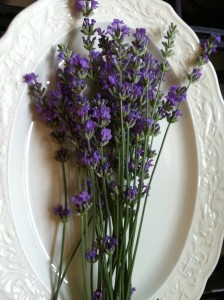Herb gardens are a fun way to ease into gardening. Most herbs are undemanding and hardy; for the most part, herbs will grow in poor soil, do well in sun and partly sunny spots, and don’t mind the dry or hot weather that often comes our way. They are thrivers and survivors, often neglected because they are just too easy to get along with.
My experience with herbs is that, being so easy to plant and grow, they can be underappreciated. Sometimes herbs are planted, in part because they are “useful” plants, but then forgotten about and not put to any use.
Take our lavender, for example. We have several healthy plants around the garden, and we have continued to add plants to our garden because we like lavender.
One minor triumph in a season of irregular (for many reasons) gardening is that I’ve have been harvesting lavender flowers. The best time to harvest lavender is before the buds open, and I usually remember that when the plants are in full bloom. I’ve done better than that this year. A half a dozen nice bundles of lavender are drying even as I write.
Harvesting herbs gives a gardener the chance to enjoy the benefits of the plants, but it also is good for the plants themselves. Many herbs such as thyme, oregano, and basil will get “bushier” following a trim or pruning and make for a second harvest later in the season. Most herbs are at their peak just before flowering, so it’s a good idea to pay attention to the plant’s life cycle.
The best time to harvest herbs is in the morning after the dew has dried but before the full sun is on the plant. Wash the stalks gently under cold water and dry on towels or paper towels.
Preserving herbs is a simple and straightforward process. Herbs can be dried by being hung in bunches tied with string. Put them in a dry, well-circulating area out of direct sunlight. Another method of drying herbs is placing them on cookie sheets in the oven on a low temperature of less than 180F for 2 to 4 hours.
Some people like drying herbs in the microwave. This isn’t a method I use, but it is supposed to work fine for small batches of herbs. Place a single layer of clean, dry leaves between two paper towels and microwave on high for 1 to 2 minutes. Let the leaves cool and test. If they are not brittle enough to crumble easily, microwave them for another 30 seconds.
Some herbs, like mint or basil, may darken if dried in sunlight. To avoid that problem, place clean, dried herbs inside a paper bag and hang in a well-ventilated area to dry. It works surprisingly well, and the paper bag makes collecting the leaves as you remove them much easier.
Herbs can also be frozen. Coarsely chop clean herbs and place them in a water-filled ice cube tray. Freeze solid and then place the herb ice cubes in freezer bags.
When drying herbs, make sure that the herbs are completely dry before storing in air-tight containers. I like to use pint jars or recycle herb jars or other small jars to store and enjoy my garden herbs all year long.



